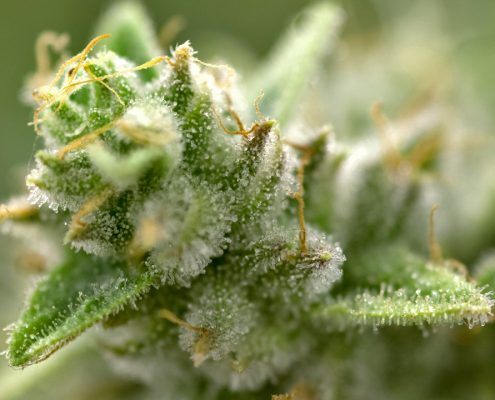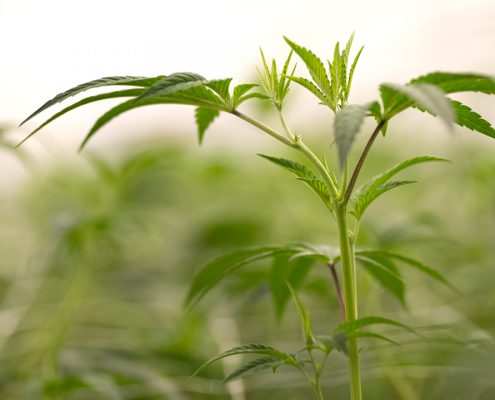GMOs, or genetically modified organisms, paint the covers of health magazines, newspaper headlines, and health food campaigns, just to name the most obvious places the term appears. They are a topic of contention and controversy, and are a hot button issue in today’s modern agricultural industry and business.
How do the technology, ethics, and implications of genetic modification relate to the world of cannabis cultivation? As an industry that has seen remarkable growth and acceptance into the mainstream, the role of genetic modification in the large-scale cannabis agricultural industry cannot be ignored. We’ll break down the fundamentals of what defines genetically modified organisms and foods, and the technologies that drive them. We want to put GM crops and foods into perspective, and more specifically, discuss the impacts that GM crops may have on both the environment and on human health.
What is a GMO?
Both traditional plant breeders and genetic engineers work with the aim of conferring some type of desirable trait onto an organism that does not yet have that characteristic. Agriculturally, this typically means an attempt to confer resistance to herbicides or pesticides, to confer volume or size, or to confer resistance to tricky growing conditions such as drought or bad soil. Such modified crops, whether they are produced by traditional crossbreeding between carefully ordained parent plants or by genetic modification, are an appealing group because the product is a crop that theoretically requires less pest and weather management because it has desirable traits that make it more robust and easier to grow and harvest.
The big difference between traditional breeding and genetic engineering is that the latter is a laboratory-developed technique which physically moves a gene from one organism and into another. Traditional breeding, though it also aims to alter the genome, or genetic makeup, of an organism, is limited to naturally occurring traits that are already present in that species’s gene pool.
The idea of selectively breeding by choosing specific traits that one wishes to have in a plant is in fact the bread and butter of successful harvesting and grow operations. Mother Nature relies on this principle in a way (per Sir Charles Darwin’s Theory of Natural Selection), and farmers centuries over have mimicked the process artificially in selective breeding programs ever since in an effort to breed optimal products that have been shaped by careful selection. However, the move towards the precision and exacting control of genetic modification came about perhaps as a response to the perceived shortcomings of traditional breeding. Since traditional selective breeding programs co-opt a plant’s natural breeding organs and machinery, the biological process in and of itself remains the same — the only difference is that humans are controlling which plants cross with which, thereby attempting to control what traits may appear in the offspring.
This traditional process still allows for the unregulated exchange of genes though, and means that farmers must concede to the biological heredity process which can pass down both desirable and undesirable genes and the traits for which they code. That margin of randomness and entropy is exactly what genetic engineering seeks to eliminate. Genetic modification is the latest manifestation of this ambition, but many take issue with the method, and argue that the risks far outweigh the benefits in this equation.
GMOs: Terminology and some basics
There are several terms that are used within and without of the industry when it comes to genetically modified organisms and the information surrounding them. Oftentimes, groups are using several synonymous phrases and terminology to describe similar objects.
First and foremost, genetically modified organisms are the result of when a gene (or multiple genes) is transferred from one organism to another in order to induce intentional change in the affected organism. This organism can include animals and plants, as well as microorganisms such as bacteria. The organism which receives a gene and the biological lab process of these modifications can be described as transgenic.
Genes can be transferred from one organism to another through a number of transgenic techniques that have been developed over the years as modern biotechnology and scientific understanding of gene expression and gene mechanics have improved. This group of techniques is referred to by a number of phrases, including gene technology and genetic engineering. These various transgenic technologies produce genetically modified organisms (GMOs) that can be further specified as GM crops, GM food, etc.
Why might one (or a whole industry) want this capability? Genetic engineering does have its advantages. The technique allows for traits to be introduced into a gene pool one at time and without complications because of the sterile laboratory conditions and complete technical control of the process. Not only can engineers employ precise management over the genetic changes that are introduced into an organism, but have the scientific capability to incorporate genes across unrelated species since they are working at sub-organismal levels– all organisms share the same genetic building blocks, and can therefore, be manipulated quite similarly at that sub-cellular level.
Current and Potential GMOs in Agriculture
Currently, GM crops have a few general targets: increasing crop yield, decreasing the cost of production, increasing pest resistance, decreasing maturation time, and increasing environmental tolerance to environmental stressors such as aluminum, salt, drought, and frost. There is a rich variety of uses and applications for genetically modified organisms which can be of value and of benefit to humans. Many have made the argument that GMOs can play a key role in reducing world hunger by making crops more readily available and more easily sustained in regions of fallow or unsuitable agricultural land.
There are a number of products which are already approved for commercial use, while other products are still in development and represent the potential advancement of what can come of genetic modification in agricultural crops (see Table 1). Future directions for genetic engineering include plant-derived vaccines (essentially medicine that can be administered through a food) or commercially valuable plant proteins that can be used in a variety of applications such as tissue surgery.
GMOs outside of Agriculture
Genetically modified organisms are hugely applicable across a number of disciplines. The process is a well-developed protocol that is used ubiquitously in laboratories, universities, hospitals, and other research institutions across the globe. While much of the populace is familiar with GMOs because of their prevalence in the discussion of organic food and sustainable farming, the techniques behind genetic modification and the products which have resulted in other significant fields such as medicine have been of huge benefit to mankind.
For instance, the developments for several vaccines against diseases such as Hepatitis B were only possible from genetic technology. Insulin treatments for patients suffering from diabetes were also a result of developments and advancements in this technology.
Are GMOs safe?
Though it is important to be clear that genetic modification is NOT creating new species (as the most cynical of GMO critics may claim), foreign genetic alterations to an organism’s genome can definitely result in unintended consequences that go beyond simply introducing a desirable trait into the host. The risks associated with GMOs are generally discussed in two main branches — the effect of genetically modified crops on human health and on the environment.
Altered organism can present significant changes in its metabolism, growth rate, and response to environmental factors. Additionally, not only can genetic alteration affect the genetically modified organism itself, but also has far-reaching implications upon the organism’s surroundings, whether that is another organism that ingests it or the natural environment in which it lives.
Effects on Human Health
There are specific systems in place for evaluation of GM organisms and their effects on public safety and health. These tests focus on assessing toxicity (i.e. a GM organism’s direct effects on human health), allergenicity (the potential of new allergens present in the GM crop), stability of the inserted gene, and the nutritional effects of the gene modification upon the crop. While the majority of studies have deemed GM organisms not to be directly toxic to human health, the immediate and long-term consequences are of concern. Potential exposure of the public to new allergens found in the GM crop as well as transfer of antibiotic-resistance to the human gut during digestion and metabolization should be considered in the potential risks to human health associated with circulation of GM crops into the public.
Effects on the Environment
By releasing genetically modified organisms into the environment, engineered genes can directly affect wild populations of that same organism through a process known as outcrossing. This occurs when GM crops naturally mix with the wild population and suddenly introduce the laboratory-engineered trait into the naturally occurring pool of genetic characteristics that can now spread throughout the population. Such outcrossing can lead to a number of unintended consequences on the surrounding environment and species. For instance, a gene for pest-resistance which was not originally a part of the natural gene pool, could make its way into the wild population, significantly altering which plants within the population survive and outlast the others, whereas before there was environmental balance between systems. Barring the risk of outcrossing, a GM type of crop could simply wipe out the wild type crop as it outcompetes for resources and is able to survive better in severe and/or unfavorable conditions. Either way, GM crops have the capability to threaten the viability of the wild cohort, a significant consideration when it comes to delicate ecosystems and conservation efforts.
These GM crops can also influence other natural populations which are not intended to be targets of the genetic modification. For instance, pest-resistant GM crops can negatively affect susceptible species that were never targeted in the first place. These would include other insects or small animals that were not the intended pests, per se, but are unwittingly implicated in the GM crop’s effects on the natural environment and ecosystem. An even more maligned consequence is the development and emergence of organisms classified as superweeds and superbugs. These are plants and pests whose populations evolve in response to the increase in herbicide-resistant crops that they normally feed upon. These superweeds and superbugs are much more difficult to manage, and usually result in a need for increased chemical pesticide use– a direct contradiction to the initial targets of genetic modification. Such evolving populations in the wild is natural selection’s ironic way of responding in like to mankind’s attempts at overcoming Mother Nature.
The Current State of GMOs
At present, the number of genetically modified organisms under development and in production is steadily rising. This is a result of improving laboratory techniques, improved tools for sequencing whole genomes, better processes for cloning and transferring genes, and the scientific community’s improved understanding of gene expression systems. There is no doubt that this list of successful scientific and technical progress is crucial to improving global health, science, medicine, and research overall, but as such technologies and techniques continue to become more sophisticated and more varied, the associated applications and downstream products must be approached, analysed, and utilized with a similar degree of critical thinking and discussion.
Awareness
In the United States, there is not a requirement to label genetically modified products as such. However, in response to this dearth of transparency, the Non-GMO Project was developed in an effort to respect consumer choice and give the public options. The Project established a labelling system that would explicitly label products which had not been created as a result of genetic modification.
Once GMOs are released into the environment, their effects cannot be recalled. While we weigh the potential benefits of decreased agricultural prices and increased nutritional gains, it is paramount to compare these to the potential risks involved and determine which route the industry should pursue. It is true that genetic modification encompasses an enormous array of plants, animals, and microorganisms, and thusly, can be approached on somewhat of a case-by-case basis. So as cannabis cultivators, scientists, and advocates, what is our determination?
Works Referenced
Barta, A., et al. The expression of a nopaline synthase-human growth hormone chimaeric gene in transformed tobacco and sunflower callus tissue. Plant Molecular Biology 6, 347–357 (1986)
Beyer, P., et al. Golden rice: Introducing the β-carotene biosynthesis pathway into rice endosperm by genetic engineering to defeat vitamin A deficiency. Journal of Nutrition 132, 506S–510S (2002)
Devos, Y., et al. Ethics in the societal debate on genetically modified organisms: A (re)quest for sense and sensibility. Journal of Agricultural and Environmental Ethics 21, 29–61 (2007) doi:10.1007/s10806-007-9057-6
Duke, S.O., & Powles, S.B. (2009). “Glyphosate-resistant crops and weeds: Now and in the future.” AgBioForum, 12(3&4), 346-357.
Fernandez-Cornejo, Jorge, and Seth James Wechsler. “USDA ERS – Adoption of Genetically Engineered Crops in the U.S.: Recent Trends in GE Adoption.” USDA ERS – Adoption of Genetically Engineered Crops in the U.S.: Recent Trends in GE Adoption. United States Department of Agriculture, Economic Research Service, 09 July 2015. Web.
“Frequently asked questions on genetically modified foods.” World Health Organization. World Health Organization, n.d. Web. 30 Nov. 2016.
Hiatt, A., et al. Production of antibodies in transgenic plants. Nature 342, 76–79 (1989)
Hoban, T. Public attitudes towards agricultural biotechnology. ESA working papers nos. 4-9. Agricultural and Development Economics Division, Food and Agricultural Organization of the United Nations (2004)
Losey, J., et al. Transgenic pollen harms monarch larvae. Nature 399, 214 (1999) doi:10.1038/20338
Ma, J., et al. The production of recombinant pharmaceutical proteins in plants. Nature Reviews Genetics 4, 794–805 (2003) doi:10.1038/nrg1177
Mortensen DA, Egan JF, Maxwell BD, Ryan MR, Smith RG. “Navigating a critical juncture for sustainable weed management.” BioScience. 2012;62(1):75-84.
Muir, W., & Howard, R. Possible ecological risks of transgenic organism release when transgenes affect mating success: Sexual selection and the Trojan gene hypothesis. Proceedings of the National Academy of Sciences 96, 13853–13856 (1999)
“Newsroom.” Agent Orange: Background on Monsanto’s Involvement.
Sears, M., et al. Impact of Bt corn on monarch butterfly populations: A risk assessment. Proceedings of the National Academy of Sciences 98, 11937–11942 (2001)
Spurgeon, D. Call for tighter controls on transgenic foods. Nature 409, 749 (2001)
Takeda, S., & Matsuoka, M. Genetic approaches to crop improvement: Responding to environmental and population changes. Nature Reviews Genetics 9, 444–457 (2008) doi:10.1038/nrg2342
United States Department of Energy, Office of Biological and Environmental Research, Human Genome Program. Human Genome Project information: Genetically modified foods and organisms, (2007) “Center for Food Safety | Issues | GE Food Labeling | International Labeling Laws.” Center for Food Safety.





